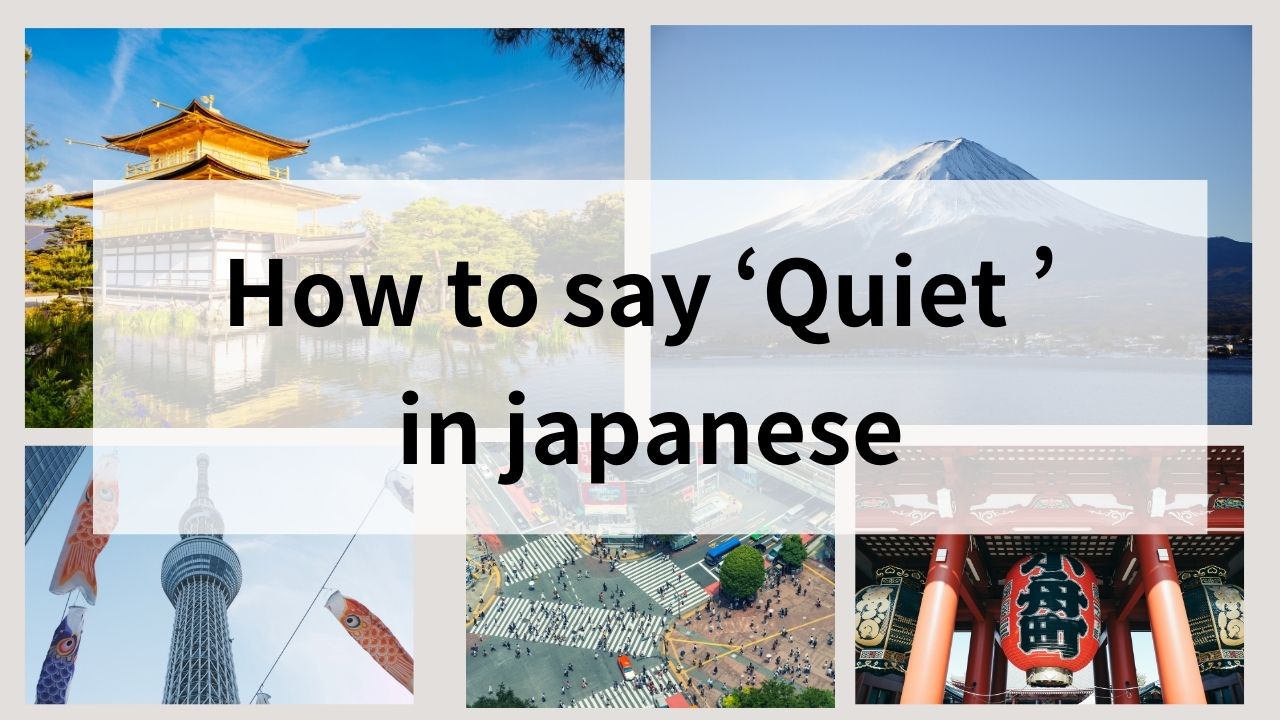Are you curious about how to say “quiet” in Japanese? The concept of quietness holds various cultural meanings and associations in Japan, reflecting both social etiquette and personal space. This guide will explore the Japanese word for “quiet,” its cultural significance, and practical applications.
How Do You Say “Quiet” in Japanese?
The Japanese word for “quiet” is 静か (shizuka). This term is widely recognized and used in both casual and formal contexts. The concept of quietness in Japan is often associated with tranquility, respect, and consideration for others.
The Japanese Word for Quiet: Shizuka (静か)
“Shizuka” is used to describe a state of quietness and can be found in various phrases and contexts. For example:
- 静かな場所 (Shizuka na basho): “Quiet place.”
- 静かな夜 (Shizuka na yoru): “Quiet night.”
- 静かにして (Shizuka ni shite): “Please be quiet.”
Kanji for Quiet: 静
The kanji for quiet, 静, is commonly used in literature and everyday language. This visually striking character reflects the essence of tranquility. The primary reading for this kanji is しず (shizu), but it can also be read as せい (sei) in certain contexts.
Examples of words containing the kanji 静 include:
- 静寂 (Shijaku): “Silence” or “stillness.”
- 静止 (Seishi): “Stillness,” often used in contexts like photography or motion.
- 静音 (Shiuon): “Silent” or “quiet sound,” commonly used in technology contexts.
This kanji is associated with the idea of calm and tranquility, reflecting the cultural value placed on quietness in various aspects of life. Recognizing these patterns can help learners understand the nuanced use of 静 in Japanese.
Does “Quiet” Work in Japanese?
The English word “quiet” is generally understood in Japan, especially among younger generations or those familiar with modern culture. However, its recognition might be less universal among older individuals or in more traditional contexts. A 5-point scale rates its comprehension as:
- Rating: 4 – Generally understood (60-80% of people)
Rating Details
Understanding the 5-Point Rating for English Words in Japan
The following ratings help explain how English words are typically understood in Japan. The scale is based on context, familiarity, and the target audience.
- 5 - Universally understood (80% or more):
Words that are widely adopted into everyday Japanese, such as "coffee" (コーヒー) or "computer" (コンピューター). These words are part of the standard vocabulary and are recognized by nearly everyone. - 4 - Generally understood (60-80%):
Words that are familiar to most people but might require context for full comprehension. Examples include terms commonly used in specific industries or by younger generations. - 3 - Understood in half of the cases (40-60%):
Words that depend heavily on pronunciation or context. For example, technical terms or less common foreign words that some people may not immediately recognize. - 2 - May not be understood (20-40%):
Words that are unfamiliar to most Japanese speakers unless they have significant exposure to English or specific cultural contexts. These words are often better replaced with their Japanese equivalents. - 1 - Rarely understood (20% or less):
Highly specialized or obscure terms that are unlikely to be recognized by the general public. Clear communication requires the use of Japanese vocabulary or additional explanation.
This rating system provides a practical guide for determining when and how to use English words effectively in Japan. Understanding the audience and context is key to ensuring clear communication.
If clarity is crucial, using the Japanese term 静か (Shizuka) is recommended. While “quiet” may be understood in certain contexts, “shizuka” ensures effective communication.
The Cultural Significance of Quiet in Japan
Quietness holds a special place in Japanese culture, symbolizing respect, harmony, and mindfulness. It is often valued in various social settings and is considered an essential aspect of daily life.
Quietness as a Cultural Norm
In Japan, being quiet in public spaces is seen as a sign of respect for others. For instance, on public transportation, it is common for people to speak softly or refrain from talking altogether, allowing for a peaceful environment.
Quiet in Japanese Folklore and Traditions
Quietness is often celebrated in Japanese folklore and traditions, reflecting the beauty of nature and the importance of introspection. The concept of “ma,” which refers to the space or pause between things, emphasizes the significance of quiet moments in life.
In addition to its traditional associations, quietness plays a significant role in modern Japanese pop culture, particularly in art and literature, where it often symbolizes inner peace and contemplation.
Differences Between Quiet in Japan and Overseas
Yes, there can be subtle differences in how “quiet” is perceived in Japan versus Western cultures. In Japan, “shizuka” (静か) often refers to a more profound sense of calm and tranquility, whereas in Western contexts, “quiet” may sometimes imply a lack of noise without necessarily conveying a sense of peace or calmness. Understanding these cultural nuances can help avoid confusion, especially when discussing social behaviors or environments.
Practical Applications of “Quiet” in Japanese
Learning how “quiet” is used in Japanese can help you navigate conversations, understand idioms, and recognize its presence in Japanese culture.
Talking About Quiet in Daily Conversation
Here are some examples of how “shizuka” is used in everyday conversation:
- ここは静かです (Koko wa shizuka desu): “It is quiet here.”
- 静かにしてください (Shizuka ni shite kudasai): “Please be quiet.”
Quiet-Related Idioms or Expressions
While there are relatively few specific idioms involving “shizuka,” the concept is often intertwined with themes of respect, tranquility, and mindfulness in Japanese culture. Here are some expressions and phrases that incorporate or symbolize quiet:
- 静寂の時 (Shijaku no toki): “Time of silence,” symbolizing moments of reflection.
- 静かな心 (Shizuka na kokoro): “Quiet heart,” referring to a calm and peaceful mindset.
- 静かな夜 (Shizuka na yoru): “Quiet night,” often evoking images of tranquility.
- 静かなる水 (Shizuka naru mizu): “Quiet water,” symbolizing peace and serenity in nature.
These idioms and expressions reflect the deep cultural appreciation for quietness in Japan, often tied to themes of respect, contemplation, and harmony. By learning these phrases, you can gain a deeper understanding of how quiet is interwoven with Japanese language and values.
Quiet in Japanese Art or Products
Quietness is also prominently featured in Japanese art and products, showcasing its aesthetic appeal and cultural significance. Here are some notable examples:
- Zen Gardens: Designed to promote tranquility, these gardens use rocks, sand, and minimalistic elements to create a quiet space for meditation.
- Haiku Poetry: This traditional form of poetry often captures quiet moments in nature, emphasizing simplicity and reflection.
- Tea Ceremonies (茶道, Sadō): This practice embodies quietness and mindfulness, focusing on the serene preparation and enjoyment of tea.
These examples highlight how quietness is not only a cultural value but also an aesthetic principle in Japanese art and practices, adding depth and meaning to various forms of expression.
FAQs
Here are some frequently asked questions about quiet in Japanese culture and language.
Is Quiet a Valued Concept in Japan?
Yes, quietness is a highly valued concept in Japan, often associated with respect, harmony, and mindfulness. It is considered essential in both social interactions and personal enrichment.
How Do You Write “Quiet” in Japanese?
The word “quiet” can be written in three different scripts in Japanese: hiragana, katakana, and kanji. Each script serves different purposes depending on the context and formality. Here’s a breakdown:
- Hiragana (しずか, Shizuka):
Hiragana is the most commonly used script for “quiet” in casual writing or when teaching children. It is simple and easy to read, making it ideal for everyday use. - Katakana (シズカ, Shizuka):
Katakana is rarely used for “quiet,” but it may appear in stylistic contexts, such as advertisements or product names. - Kanji (静, Shizuka):
Kanji is the most formal and traditional way to write “quiet.” It is often used in literature, official documents, and cultural contexts. The kanji itself conveys a sense of tranquility and respect.
Choosing which script to use depends on the tone, audience, and purpose of your communication. Understanding these variations can enhance both your written and spoken Japanese skills.
Conclusion
Quiet, or “shizuka” in Japanese, is more than just a state of being—it symbolizes respect, tranquility, and cultural significance. By understanding its role in Japanese language and traditions, you can deepen your appreciation for the value placed on quietness in Japanese society.








